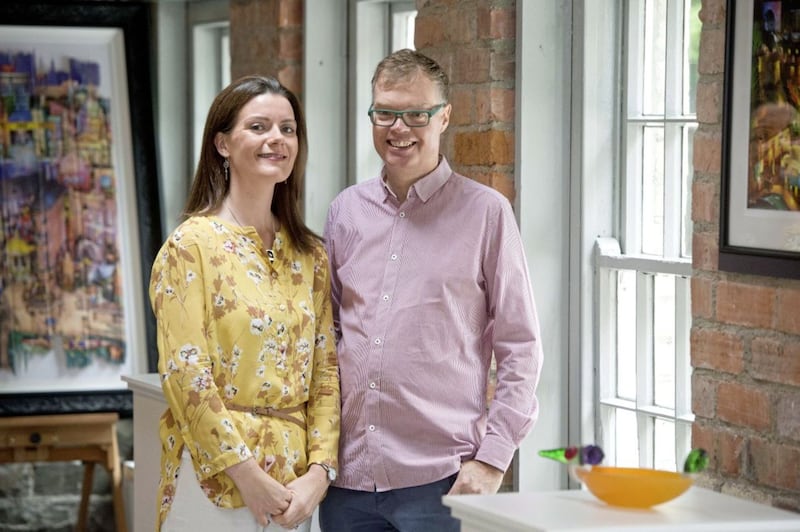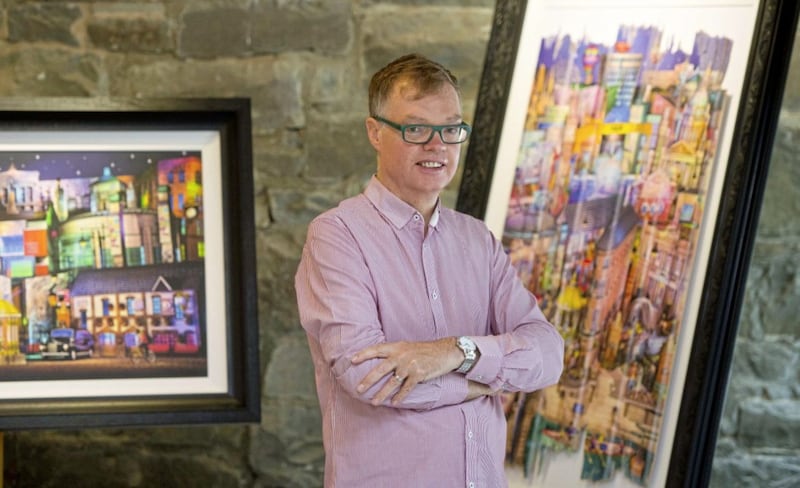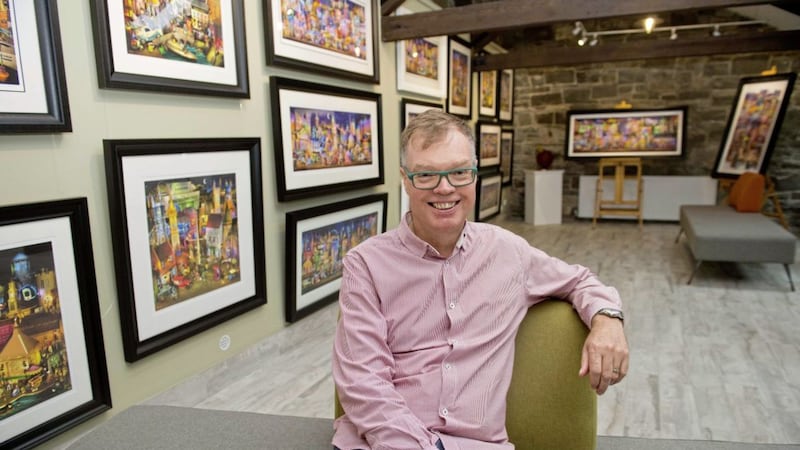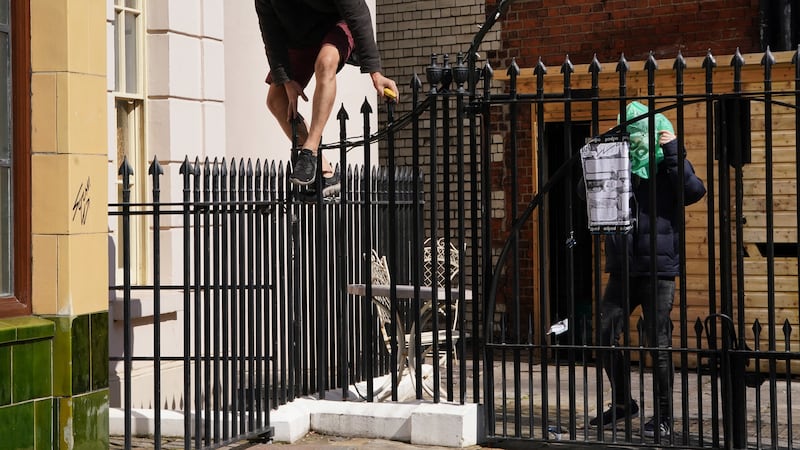PEDESTRIANS strolling star-spangled streets appear slightly over-sized, while a trio of massive cupcakes could easily be Brobdingnag leftovers from Jonathan Swift's curious Land of Giants.
Parked vans are similarly out of proportion to the familiar-looking buildings in this dreamlike Belfast cityscape – or is it just a matter of perspective?
If nothing is as it seems in Keith Drury's colourful modern-day masterpieces, that is how the artist intended, with missized additions, humorous social commentary – as well as a few hidden secrets – studding his distinctively quirky 'When I dream' prints which hang in famous homes and galleries across the world.
These are exciting times for the leading contemporary digital artist who has painted Brazilian footballing ace, Pele, and recently presented a limited edition of London Way to Princess Anne in London – "well, her mum's house was in it," – with a new exhibition having just opened in Belfast's Grand Opera House.
But, while happy his vibrant, larger-than-life scenes of his beloved Belfast will adorn the walls of the theatre until the end of the year, Drury is feeling particularly inspired by a new extension of his art (created with the same software used by Disney and Pixar) into the 3D world of virtual reality.

He is currently involved with an innovative research project with Queen's University to create a virtual reality (VR) programme – using his art in three-dimensional form – to help children with autism.
"The project will create a game-based activity in a virtual environment to help children on the autistic spectrum learn coping mechanisms," he says. "We're using new technology to bring the buildings of Belfast alive and open up a new world of learning."
His wife, Deborah, a former teacher who now manages the art business based in Crossgar, is using the project for a doctorate in education and says it has been designed initially to empower children with autism.
One of her former pupils, Matthew McComb, a games developer who has Asperger syndrome, is spearheading the initiative and now works full-time with the Drurys in their 'Dream Factory' at the Potting Shed studios situated on the edge of the Tobar Mhurie estate.
"It is a philanthropic project and aims to use Keith's art and VR technology to test predictive impairment in autistic children who find it difficult to cope with the unexpected," Deborah explains. "We have set up different scenes in a cafe, supermarket and airport where they are encouraged to make different choices when things go 'wrong'."

For her husband, it brings the opportunity to see his landmark Belfast buildings – including Muriel's bar and its hanging underwear – spring to life in the original 3D format from which they are 'moulded' on a specially constructed high-power computer screen.
"It is really exciting as no-one else is doing this at the moment," he says. "For me, it about art pushing the boundaries, pushing against convention and going somewhere new – which is what art is meant to do and has always done throughout the ages.
"When I am creating the paintings on the computer, it is like 3D modelling and I am creating everything from scratch, but the end product is flat, so this VR project is giving them real form again. Art has many dimensions and it doesn't have to be just looking at a painting on a wall."
It is art at the cutting edge, but fans of Drury's detailed city prints – available on paper, canvas and, more recently wood – have already enough going on, just studying them with the naked eye.
"There is certainly detail overload," he agrees, "and many people, especially people from Bristol, for some reason, get out their magnifying glasses and even have competitions to find and count the buildings."
They won't unearth every detail, though, because the 54-year-old, who studied business and economics at university and then completed a second degree in theology, allows himself a little inside joke. He "hides things" for his own amusement in each piece, some of which take months to complete.
"Humour is a big part of my work, as well as the social commentary on Brexit or the state of local politics," Drury reflects. "Mostly, though, I create cities as a celebration of where people live and work. There is always a positive message, as well as a slightly humorous take on life. I'm lucky, though, that I haven't had a lawsuit filed for a few of the jokes."
After wearing a collar as a Presbyterian minister for 17 years, the artist, who has two children from a previous marriage, became "disillusioned" with the Church as an institution and left the ministry.
A strained relationship with his former employers was probably not eased by a self-portrait in which a figure is seen running away with "the Monet" (painting), a non-too-subtle reference to the Presbyterian Mutual Society crisis in 2008, but he has also alluded to paedophilia cover-ups by the Catholic Church, and, in more playful mood, depicted an Orangeman kissing a nun in The Goose of St George.
"The kiss was only in a reflection, so it would likely be missed by the casual observer," he says. "I like to leave things open to interpretation and I think art has to say something, just like life."
Entirely self-taught, he first came to public attention in 2010 after winning a public competition launched by Belfast City Council (his sister was also among the five finalists) to interpret Irish heritage – his resulting oil portraits are on permanent display at the city hall.
But, although he learned to paint by "copying others" he rose from imitator to artistic pioneer after stumbling upon his current technique almost by accident.
"I was working as a book designer when I became frustrated that the client kept adding text, meaning I had to change the way I had drawn a child's hand – which was either pointing up or down according to the position of the text on the page," he recalls. "I remember thinking, 'if only I could make his arms move...
"It sent me on a search of a software programme and I became increasingly intoxicated by the process. It wasn't easy to learn, though, and my first attempt resulted in three cups stacked on top of each other. It looked so rudimentary, but I was just amazed I had created a cup."
Today, his famous city scenes– always including a red telephone box and post box, wherever the city – are daringly complex and he will deliberate for hours over perfecting details on something as inconsequential as a perforated brake disc on a Harley-Davidson.
"No-one else will notice if I've got that right, but it's important to me," he adds. "I may play around with time and scale, but I like details to be correct. That's was I love about this type of art – it's creative, but it's also clean and precise.
"The exact angle light hits water and how it bends will follow the law of physics, for example. I love buildings and I love cities and I can get happily lost wandering around them for hours, even if it's just up here in the studio."
:: For more see keithdruryart.com




